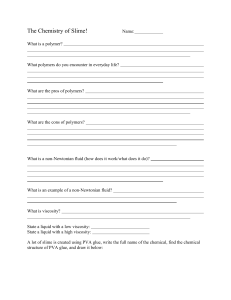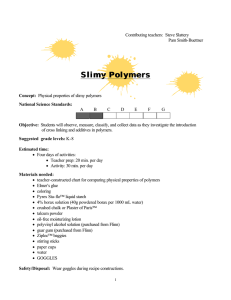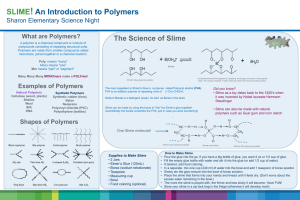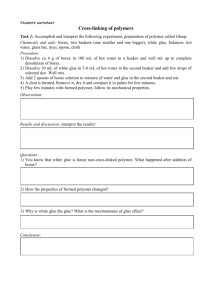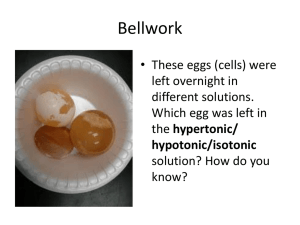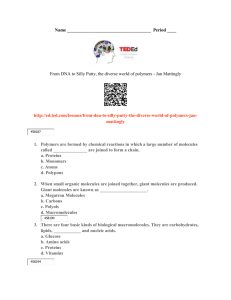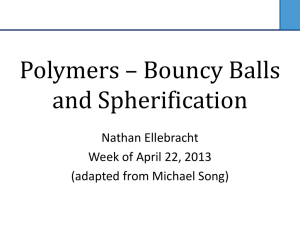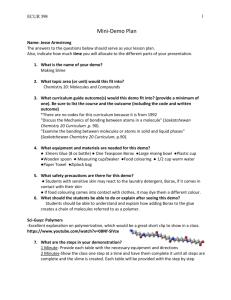Fun With Slime
advertisement
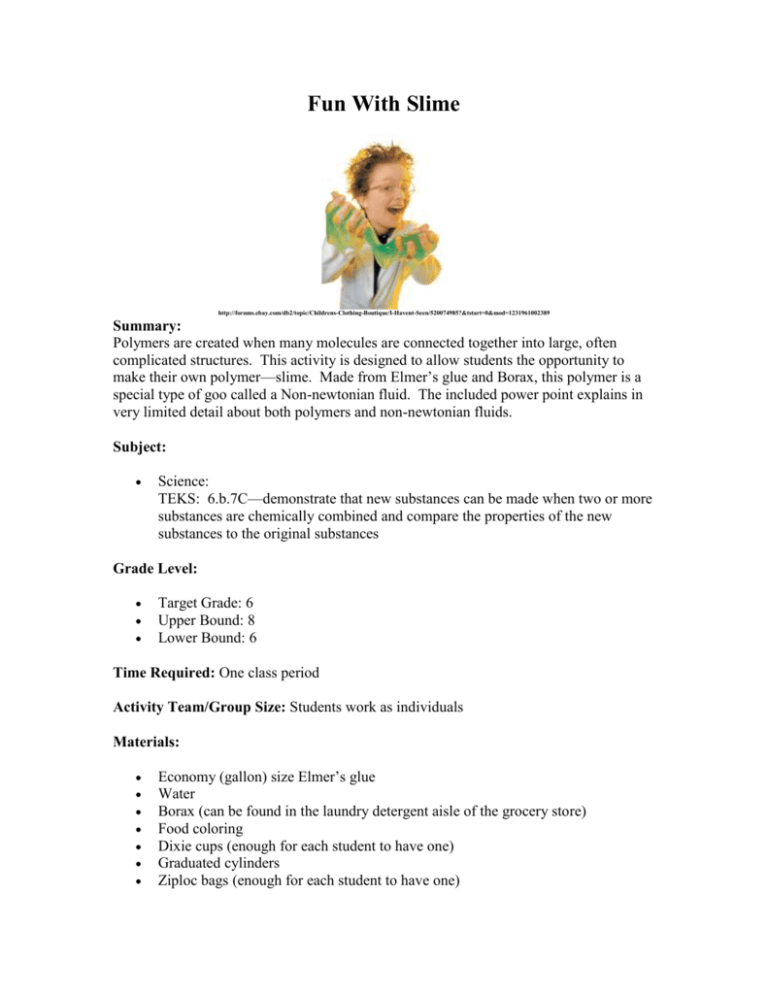
Fun With Slime http://forums.ebay.com/db2/topic/Childrens-Clothing-Boutique/I-Havent-Seen/520074985?&tstart=0&mod=1231961002389 Summary: Polymers are created when many molecules are connected together into large, often complicated structures. This activity is designed to allow students the opportunity to make their own polymer—slime. Made from Elmer’s glue and Borax, this polymer is a special type of goo called a Non-newtonian fluid. The included power point explains in very limited detail about both polymers and non-newtonian fluids. Subject: Science: TEKS: 6.b.7C—demonstrate that new substances can be made when two or more substances are chemically combined and compare the properties of the new substances to the original substances Grade Level: Target Grade: 6 Upper Bound: 8 Lower Bound: 6 Time Required: One class period Activity Team/Group Size: Students work as individuals Materials: Economy (gallon) size Elmer’s glue Water Borax (can be found in the laundry detergent aisle of the grocery store) Food coloring Dixie cups (enough for each student to have one) Graduated cylinders Ziploc bags (enough for each student to have one) Popsicle sticks for stirring Large, empty container with lid (you’ll need 2) for making up borax solution and glue/water solution. Reusable Activity Cost Per Group [in dollars]: $10-20 The unused Borax powder can be used in the future, as well as the food coloring, and any of the remaining materials. The glue might solidify over time. Expendable Activity Cost Per Group [in dollars]: Everything left over from this experiment can be re-used the next year. Learning Objectives: To help students see that when two substances are combined they can create an entirely new/different substance. To understand how the new substance is the same/different from the two original substances. To introduce the concept of both polymers and non-newtonian fluids. To show students first-hand how cross-linkers work to create polymers. Lesson Introduction / Motivation: To prepare the students for this activity you can go through the provided powerpoint slides, or whether you need to scale up or down based on your classes you could make one of your own. Lesson Plan: To introduce the concept of polymers and non-newtonian fluids you can show the powerpoint presentation titled “What are polymers”. Included in the presentation is a link to a Steve Spangler website that has a video that details the experiment they are going to do today and talks in a little more detail about the chemistry involved in crosslinking polymers. Have students go to different stations to measure out the required amount of glue/water mixture (30mL) and borax solution (10mL). After students have made their slime, they can play with it and record their observations on the worksheet (“Polymers and Slime”). Lesson Closure: Have the students discuss why the addition of the borax solution causes the glue to become slime/goo (basically what cross-linking is, and how it results in the final polymer). Assessment: By grading their worksheets, you can determine if the students have grasped the concepts of polymers and non-newtonian fluids adequately. Vocabulary / Definitions: Polymer—a naturally occurring or synthetic compound consisting of large molecules made up of a linked series of repeated units (called monomers). Non-newtonian fluid—a fluid which has properties of both solid and liquid (cannot be described by regular Newtonian physics). Cross-linking—bonds that link one polymer chain to another. They can be covalent or ionic. Background and Concepts for Teachers: Knowledge of polymers and non-newtonian fluids. Lesson Scaling: This lesson could be scaled up by having students experiment with adding different amounts of glue/water mixture and borax solution. Additionally, the addition of starch to the slime will result in a more rigid slime. To scale this lesson down, the students can be provided the glue/water mixture in one cup, and the borax mixture in the other cup—they can make observations about each cup and then combine the two and record their observations about the resulting slime. Lesson Extensions: To further the lesson, the students could do a take-home project where they choose a synthetic polymer and research the background of the structure, function, and original inventor of the polymer. Safety Issues: Slime should be kept out of reach of small children as they might be interested in eating it. Also, with the addition of food coloring, slime can stain hands (if played with overmuch), carpet, and walls. Students need to be heavily cautioned about all of these safety concerns. Troubleshooting Tips: The major troubleshooting for this activity will come with combining the correct ratios of glue/water and borax. A 3:1 ratio works very well, but experimenting with different ratios is something fun the students could do. Multimedia Support and Attachments: http://www.madsci.org/experiments/archive/878680114.Ch.html http://www.stevespanglerscience.com/experiment/00000039 http://pslc.ws/macrog/kidsmac/index.htm What are polymers powerpoint Polymers and Slime worksheet References: http://www.madsci.org/experiments/archive/878680114.Ch.html http://www.stevespanglerscience.com/experiment/00000039 http://pslc.ws/macrog/kidsmac/index.htm Keywords: Polymers Cross-linking Non-newtonian fluids Slime Authors: Graduate Fellow Name: Lauren Schilling Teacher Mentor Name: ___ Undergraduate Fellow Name: ___ Date Submitted: ___ Date Last Edited: ___ Please email us your comments on this lesson: E-mail to ljohnson@cvm.tamu.edu Please include the title of the lesson, whether you are a teacher, resident scientist or college faculty and what grade you used it for. Teacher’s Comments:
